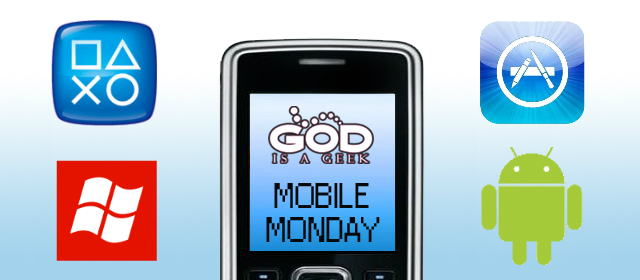You know what day it is? It’s Monday again and that can mean only one thing here at GodisaGeek: It’s time for another edition of Mobile Monday, the article where we take a look at four mobile games and let you know if they’re worth your time and money.
This week we’re taking a look at Electric Tentacle from Unit 9, Jumpster from VOGAT, The Magician’s Handbook 2 from BC Soft Games and Speed Kittens from Grey May.
Read on to find the full reviews of each game, but don’t forget to come back next week for more Mobile Monday reviews. While you’re here, if you have played any of the games listed, or even just want to come back once you’ve had a go to let us know how you got on, we’d love to hear from you in the comment box at the bottom of the page.
Titles are available on iPhone and iPad unless specifically stated otherwise. If you like what you read, click the small black “App Store” button to load iTunes up and purchase the title!
![]() ELECTRIC TENTACLE:
ELECTRIC TENTACLE:
With a name like Electric Tentacle, you can’t even really have a wild stab in the dark at what the game might contain, it could be almost literally anything. However, when you’ve got the name of Chillingo attached to it there’s a small glimmer of hope that the game isn’t going to be as ambiguous as the name would suggest. Electric Tentacle, developed by Unit 9, is a take on the plethora of running left to right games, but instead of jumping, you’re using the titular electric tentacles to move your floating character around the screen. Sounds quite different on paper, but how different does it actually play?
In Electric Tentacle you’ll be chased by plenty of enemies, which you’ll be able to attack by tapping on them, but only when their mouths are open. Try and do it at any other time and you’ll only be serving to pull your character towards them; and their doom. The entire gameplay revolves around seeing how far you can get in the game by using the electric tentacles to move your character around the screen collecting stars and avoiding the enemies. The stars can be used in the game’s shop to buy equipment that can make your life in the game a little easier. Items that slow down the world affording you a bit more time to react, shields that protect you a little, and more. They’re only single use though, so spend your money wisely.
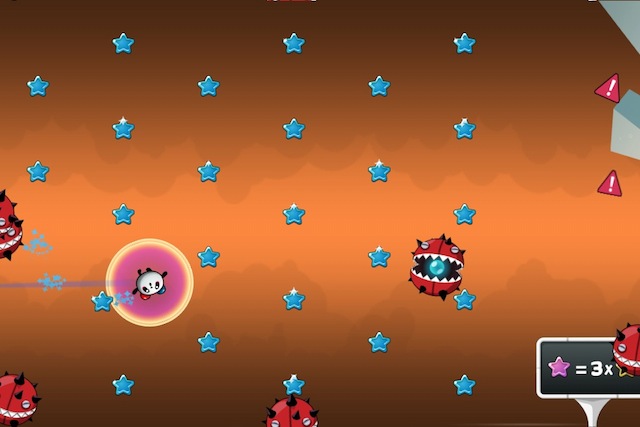
The game is heavily centred around seeing how far you can get, even going so far as placing markers in the world to indicate how far you’ve gotten on previous attempts. These are what you’ll be striving for and you’ll get an exciting feeling from passing them each and every time. There are also medals in the game which work in the same way as achievements, complete a particular feat and you’ll be awarded. It’s a nice way to keep people playing and is a nice extra that the developers didn’t have to include but which certainly adds to the gameplay and the altogether addictive nature of Electric Tentacle.
The controls are quite difficult to get to grips with, at least at first. Placing your finger on the screen will cause an “electric tentacle” to extend from your finger to the character in the centre of the screen, pulling them towards your finger. The longer you hold your finger down, the faster the character will move towards it, this makes controlling the game precisely a little difficult to do without a lot of practice. Due to the fact that controlling the main character precisely is exactly what you’re going to have to do to get the best scores, a lot of practice is your only option. Some people just don’t have the time, or the patience, for that; which is understandable.
Electric Tentacle is an enjoyable title, and one that’s easy to pick up and put down, however, if you’re not prepared to put the time in to learn the ropes and get acquainted with the major game mechanics, then you could find yourself easily frustrated with the title. The visuals are excellent and the charm and humour of the game is evident all the way through. It’s an enjoyable game, but not one that’s going to be for everyone. 

![]() JUMPSTER:
JUMPSTER:
Some games that we’ll find on the iOS App Store have very descriptive name, even if those names are only a single word long. Take Jumpster for example, developed by VOGAT, a quick look at the name and you would correctly assume that the game involves jumping around the screen in some description, although exactly what that jumping entails is the curiosity that leads you to open the game for the first time. What you’re greeted with, in Jumpster at least, is a puzzle game that will test your ability jump around the screen, collect small black blobs and get back to your spaceship. It really is quite fun.
As previously mentioned, the gameplay in Jumpster essentially involves the player using the wonders of physics to get the main character back to their spaceships which crashed onto the strange planet you find yourself on during the introduction cutscene. In order to get back to your spaceship, you’ll mainly be using your inherent ability to bounce, attempting to judge your trajectory via a small dotted line while you do so. This dotted line will tell you exactly where you’re going to land as long as you don’t hit any of the many obstacles along the way; something which gets harder and harder not to do as you progress through the levels.
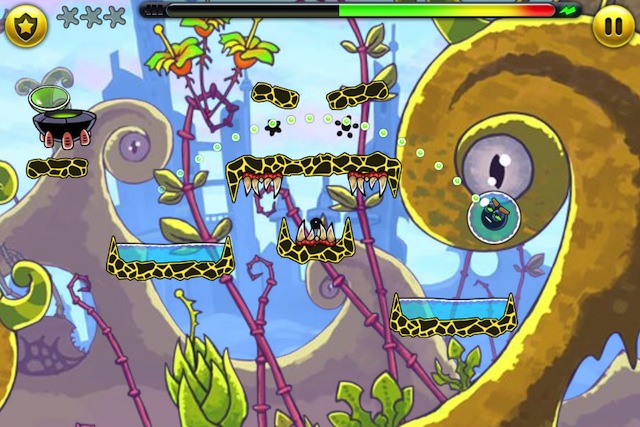
Within each of the levels there are three black blobs of fuel, these are the reason your spaceship crashed, a loss of fuel through getting hit with space debris, so it’s your job to collect it all back up in order to leave. These three pieces of fuel in each level serve as the three star system that we’ve seen in every major puzzle game since Angry Birds and let the player know, upon completion of the level, exactly how well – or badly – they performed. The goal is, obviously, to collect all three in each of the levels, but the game won’t stop you from progressing if you just want to find the quickest route to your downed vessel. Not that you would want to take the easy way out, of course.
It’s not going to take most people very long to get used to the control method in Jumpster, especially if you’ve played Angry Birds before (and, let’s face it, who hasn’t). In order to control the main character, all the player has to do is place their finger on him and pull back. The dotted line will appear to tell the player where they will land if they let their finger go. Moving the main character around will change that trajectory, then it’s just a matter of letting go of the screen with your finger and watching the character fly across the screen. It’s all very satisfying.
Jumpster is a surprisingly fun game to play for hours on end, it’s got an enjoyable art style, a decent amount of humour and gameplay that, while it has been used before, has been used extremely well here. There are plenty of levels to be getting on with too, and if you commit yourself to attempting to “three star” each of the levels, then you’re going to be playing the game for a long time to come. And enjoying each second of it while you do. 

![]() THE MAGICIAN’S HANDBOOK 2:
THE MAGICIAN’S HANDBOOK 2:
Some puzzle games that we’ll play on our iOS devices are frantic affairs, tasking us with tapping the screen of our iDevices as quickly as we can in order to get to the outcome that we want; usually completing the level and getting all of the stars, etc. Is doesn’t hurt, however, to have a game, every now and then, that the player can just sit back, relax, and enjoy. Taking their time with things but still getting the same puzzle-solving enjoyment from it. That’s exactly what Magician’s Handbook 2, developed by BC Soft Games, is. A strange mix between a ‘Spot the Difference’ game, an adventure game and various other game styles thrown in there for good measure.
The majority of the gameplay in Magician’s Handbook 2 will involve attempting to pick out objects from scene based on a list. Some of the objects that you’ll be asked to find are obvious, while others might be a little harder to find. All of them will have a small amount of magical power attached to it and, when you’ve collected enough of these magical objects, you’ll be given the chance to learn a new spell that will allow you to move a little further into the game; all in an attempt to uncover a little bit more of the mystery.
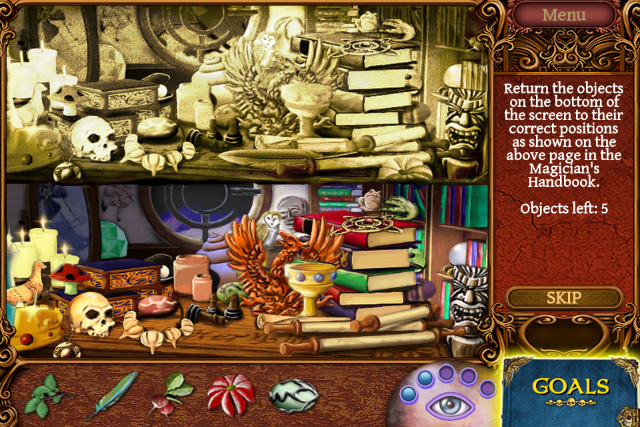
When you’re asked the learn a new spell, you’ll be presented with another gameplay style. This new style is more akin to the classic ‘Spot the Difference’ games that we’ve all played from time to time. You’ll be shown one image on the top of the screen and another image on the bottom, and told to add the items from your inventory into the scene so that both of the images match up. The top image has a sepia-esque filter applied to it, meaning that it’s often difficult to distinguish which items are missing, and where they’re supposed to be placed, but it offers a decent challenge and a nice breather from the main gameplay experienced in the rest of the title.
The controls in Magician’s Handbook 2 are easy enough for anyone to learn in a relatively short amount of time, and the simple gameplay mechanics – mostly revolving around digital versions of classic games that we’ve all played, means that the barrier to entry is quite low too. This is absolutely a game that can be given to anyone and enjoyed; despite the fact that the visuals are little lacklustre and the story leaves a lot to be desired. Still, good gameplay mechanics is what people come to these games for and Magician’s Handbook 2 delivers on that front without a doubt.
If you’re looking for a game that’s a bit different to the type of thing that you’d usually play on your way to work/school then you could do a lot worse than Magician’s Handbook 2. It’s not the best game in the world, and some of the objects are hidden in the kind of places that you’d never guess in a million years without the hints, but it’s challenging and if that’s something that you’re looking for then look no further. 

![]() SPEED KITTENS:
SPEED KITTENS:
If you spend most of your waking life on the internet, like me, then you’re bound to come across cats in some form or another. They infest the web like plague rats in 17th century London. You can probably understand then, why I immediately assumed that Speed Kitten, a game developed by Grey May, was going to plaster my iOS device’s screen with LOLCats. I was prepared, I was a little bit excited, then it didn’t happen. What I got instead was a game that’s unlike any other I’ve played recently, crazy, extreme and amazingly well-balanced at the same time.
The gameplay follows a group of cats that have figured out how to fly using a variety of different methods and, in an attempt to stop their precious milk from being stolen, have taken to the skies to take down the blimps that are doing the thieving. The gameplay revolves around the player flinging the different cats at the blimps in order to destroy them and take back that milk. The more blimps you manage to destroy in a given level, the more milk you’re awarded upon that level’s completion; and milk means prizes!
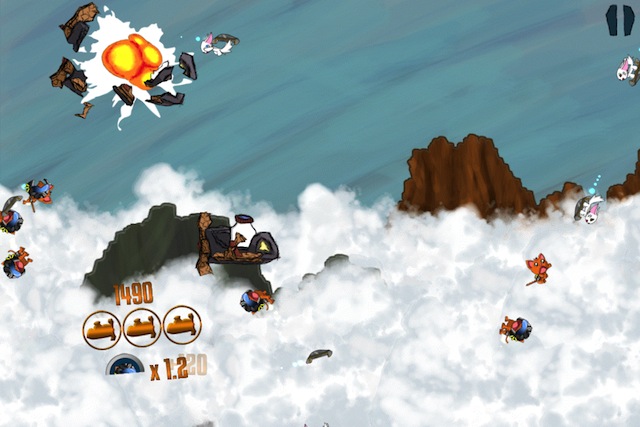
There’s a nifty little in-game store where you can spend all that milk you’ve collected over the course of your time with the game, usually spending it to unlock new cats that do different thing when used in the game, but you can also use the store to buy power ups that will give you a bit of a helping hand when it comes to making sure you’re able to survive that little bit longer. Of course, just like any game that uses intermediary currency like milk to buy things, there’s also the option to buy more milk using real money, if you’re into that kind of thing.
The controls in Speed Kittens is a little difficult to get used to at first. In order to fling a cat at one of the blimps you have to tap and hold on the cat, then drag in the direction that you want it to be flung in. This takes some getting used to, especially if you want to hit the blimps every time, but it’s worth sticking with as when you finally get it down to an art, you’ll be flinging cats left, right and centre, and enjoying every second you’re doing so.
Speed Kittens is a strange little game, but one that’s heaps of fun once you’ve gotten to grips with the madness of it all. After playing the game I’m seriously surprised it isn’t covered in LOLCats but I’m also glad of that fact. Speed Kittens is its own special brand of crazy, and the whole experience is all the more entertaining because of it. Sure, it take a little bit of getting used to, and the visuals aren’t fantastic, but it’s fun and you can’t ask for much more than that from an iOS game. 



